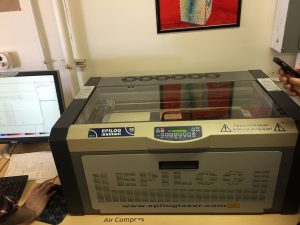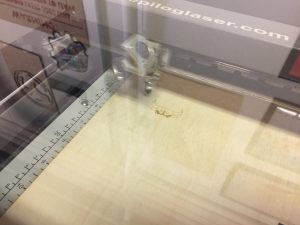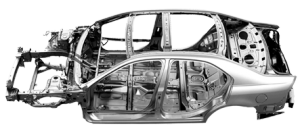Week Summary
This week, we continued with our rotations at the Champaign-Urbana community fabrication lab. Last week, I had the awesome opportunity of being able to use the embroidery machine to bring my lion to life. This week, we switched sides over to the laser cutting station, where I got to create a holder for my embroidered patch!
This was my first exposure to any sort of laser-cutting software or hardware. We used a vector graphics software called InkScape. Creating the laser-printed design was significantly easier than creating the stitched design. It was as simple as finding a .png online and making any necessary modifications to the lines in the software. Following my “king of the jungle” theme, I found a simple silhouette of a prowling lion to etch onto my box. We learned about the difference between cutting something out of the wood vs. engraving something in the wood. After finalizing our designs on Inkscape, we went over to the cutting machine itself! I had never seen one before, and it was a lot smaller, and a lot more louder than I expected.

Also, I had no idea that there was a literal laser inside the machine. I could see it flickering bright red, as it roared to life and began cutting into the wood, in the same way a 3D printer rapidly moves around a grid. I actually wished we were able to actually cut out designs in the wood, but found out that is a much more complex process than simply burning a design into the wood.
When the first designs started to come out, I was amazed at how fast the machine worked to burn the designs in – it was like seeing it appear out of thin air onto the wood. This is what one classmates’ design started to look like:

You can see here how it actually used a very fine laser beam that was extremely hot to engrave the designs we created. I was unable to see my finished product, but I look forward to collecting it when we meet at the fab lab for the last time this week!
I was curious to see how laser cutting is used in industry beyond making simple wooden boxes, and found that it is extremely relevant in the automotive industry. Automative manufacturers have started employing laser cutting techniques for extremely specific and nuanced parts because they can be made with high precision. Furthermore, it’s significantly safer than traditional methods to cut metal today, which include large moving blades. Laser cutting allows for a much smoother process. Amazing!


Hey Ajie –
Thanks for the great recap of the laser-cut boxes! I wasn’t able to make one because I was sick the first week we were in the FabLab, so I appreciate reading about it here.
“Also, I had no idea that there was a literal laser inside the machine. I could see it flickering bright red, as it roared to life and began cutting into the wood, in the same way a 3D printer rapidly moves around a grid. ”
^ Referring to your above quote, did you know that laser cutters have been assembled from the same components as 3D printers? I read this somewhere a while ago. It makes sense, seeing as how the both use a “print head” type device to deploy the laser or the plastic.
I know that they have also been using laser cutting in the aerospace industry quite a bit. I wonder how the fact that more and more carbon fiber is being used in planes (over metal) effects the use of laser cutting?
Ajie,
I was also intrigued by the laser cutting process. I was most surprised by how quickly the boards were cut, mine was done within ten minutes. The same can be said about the automatic sewing process. The automotive industry is really benefitting from laser cutting technology as it has allowed them to create very precise cuts that could prevent future failures.
Jason